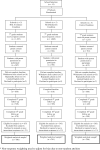Behavioral and psychosocial effects of two middle school sexual health education programs at tenth-grade follow-up
- PMID: 24445180
- PMCID: PMC4634364
- DOI: 10.1016/j.jadohealth.2013.10.204
Behavioral and psychosocial effects of two middle school sexual health education programs at tenth-grade follow-up
Abstract
Purpose: An earlier randomized controlled trial found that two middle school sexual education programs-a risk avoidance (RA) program and a risk reduction (RR) program-delayed initiation of sexual intercourse (oral, vaginal, or anal sex) and reduced other sexual risk behaviors in ninth grade. We examined whether these effects extended into 10th grade.
Methods: Fifteen middle schools were randomly assigned to RA, RR, or control conditions. Follow-up surveys were conducted with participating students in 10th grade (n = 1,187; 29.2% attrition).
Results: Participants were 60% female, 50% Hispanic, and 39% black; seventh grade mean age was 12.6 years. In 10th grade, compared with the control condition, both programs significantly delayed anal sex initiation in the total sample (RA: adjusted odds ratio [AOR], .64, 95% confidence interval [CI], .42-.99; RR: AOR, .65, 95% CI, .50-.84) and among Hispanics (RA: AOR, .53, 95% CI, .31-.91; RR: AOR, .82, 95% CI, .74-.93). Risk avoidance students were less likely to report unprotected vaginal sex, either by using a condom or by abstaining from sex (AOR: .61, 95% CI, .45-.85); RR students were less likely to report recent unprotected anal sex (AOR: .34, 95% CI, .20-.56). Both programs sustained positive impact on some psychosocial outcomes.
Conclusions: Although both programs delayed anal sex initiation into 10th grade, effects on the delayed initiation of oral and vaginal sex were not sustained. Additional high school sexual education may help to further delay sexual initiation and reduce other sexual risk behaviors in later high school years.
Keywords: Adolescents; Computer-based; Health education; Intervention studies; Sexual behavior; Urban populations.
Copyright © 2014 Society for Adolescent Health and Medicine. All rights reserved.
Figures
References
-
- Centers for Disease Control and Prevention (CDC) Youth Risk Behavior Surveillance—United States, 2011. MMWR. 2012;61:1–162. - PubMed
-
- Hamilton B, Ventura S. Birth rates for U.S. teenagers reach historic lows for all age and ethnic groups. National Center for Health Statistics; Hyattsville (MD): 2012. p. 89. - PubMed
-
- CDC. [January 31, 2013];Diagnoses of HIV infection and population among young adults aged 20-24 years, by race/ethnicity, 2010-46 states. Available at: http://www.cdc.gov/hiv/topics/surveillance/resources/slides/adolescents/....
-
- CDC Division of Adolescent and School Health [January 31, 2013];Youth online: High school YRBS. Available at: http://apps.nccd.cdc.gov/youthonline/App/Default.aspx.
-
- Flanigan CM. Sexual activity among girls under age 15: Findings from the National Survey of Family Growth. In: Albert B, Brown S, Flanigan CM, editors. 14 and younger: The sexual behavior of young adolescents. National Campaign to Prevent Teen Pregnancy; Washington, DC: 2003. pp. 57–64.
Publication types
MeSH terms
Grants and funding
LinkOut - more resources
Full Text Sources
Other Literature Sources


